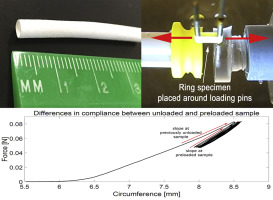Journal of the Mechanical Behavior of Biomedical Materials ( IF 3.9 ) Pub Date : 2020-01-24 , DOI: 10.1016/j.jmbbm.2020.103652 Martin Stoiber 1 , Christian Grasl 1 , Katharina Frieberger 2 , Francesco Moscato 1 , Helga Bergmeister 3 , Heinrich Schima 4

|
Aim
For the proper function of small diameter vascular grafts their mechanical properties are essential. A variety of testing methods and protocols exists to measure tensile strength, compliance and viscoelastic material behavior. In this study the impact of the measurement protocol in hoop tensile tests on the measured compliance and tensile strength was investigated.
Methods
Vascular grafts made out of two different materials, a thermoplastic polyurethane (PUR) and polylactid acid (PLLA), with three different wall thicknesses were produced by electrospinning. Samples were tested with a measurement protocol that allowed the comparison of dynamic sample loading to a common quasistatic tensile test. Influence of measurement temperature, preconditioning cycles and the influence of a high number of loading cycles was also investigated. Compliance and tensile strength were evaluated and compared between the different samples and the different load cases.
Results
In all samples a significant difference in the measured compliance was seen between an unloaded sample and a sample that was already in a preloaded state. For example in the PUR group with 100 μm wall thickness at 37 °C, the first compliance was 32.6 ± 9.6%/100 mmHg, which reduced to 15.4 ± 2.9%/100 mmHg at preloaded state. The PLLA group showed 7.5 ± 4.3%/100 mmHg vs. 0.94 ± 0.11%/100 mmHg respectively. The measurements showed the importance of dynamic testing, as the samples viscoelastic behavior had a considerable influence on the measured compliance. The quasistatic ultimate tensile test alone was not able to predict the sample's in vivo compliance. The measurement temperature had a significant influence on tensile strength and compliance. Both, the number of preconditioning cycles and the high number of loading cycles had a minor influence on the sample's compliance.
Conclusion
With a quasistatic tensile tests alone, overestimated compliance values are measured in viscoelastic electrospun vascular samples, therefore dynamic loading cycles are required. Measurements at 37 °C are mandatory, as temperature has a significant influence on the mechanical properties.
中文翻译:

测试规程对小直径电纺血管移植物力学特性的影响。
目标
为了使小直径血管移植物正常工作,其机械性能至关重要。存在多种测试方法和协议来测量拉伸强度,顺应性和粘弹性材料的行为。在这项研究中,研究了箍拉伸试验中的测量规程对所测量的柔度和抗张强度的影响。
方法
通过静电纺丝生产了由两种不同材料制成的血管移植物,它们是热塑性聚氨酯(PUR)和聚乳酸(PLLA),具有三种不同的壁厚。使用测量方案对样品进行测试,该协议允许将动态样品载荷与普通的准静态拉伸试验进行比较。还研究了测量温度,预处理循环的影响以及大量加载循环的影响。评估了柔顺性和拉伸强度,并比较了不同样品和不同载荷工况。
结果
在所有样品中,卸载样品与已经处于预加载状态的样品之间的顺应性测量值存在显着差异。例如,在37°C时壁厚为100μm的PUR组中,第一顺应性为32.6±9.6%/ 100 mmHg,在预载状态下降至15.4±2.9%/ 100 mmHg。PLLA组分别显示7.5±4.3%/ 100 mmHg和0.94±0.11%/ 100 mmHg。测量结果显示了动态测试的重要性,因为样品的粘弹性行为对测得的柔度有很大影响。仅准静态极限拉伸试验无法预测样品的体内合规性。测量温度对拉伸强度和顺应性有重大影响。预处理周期数和上样周期数均对样品的柔韧性影响较小。
结论
仅通过准静态拉伸试验,就在粘弹性电纺血管样品中测量了高估的柔量值,因此需要动态加载周期。必须在37°C下进行测量,因为温度会对机械性能产生重大影响。



























 京公网安备 11010802027423号
京公网安备 11010802027423号